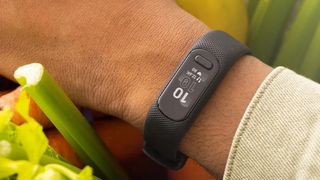Your next Garmin could have an updated high-tech blood oxygen sensor
Garmin’s Pulse Ox technology could be getting smarter

Garmin has applied to patent a new way for smartwatches to measure blood oxygen saturation levels, or SpO2. Published on May 12, the patent was originally filed in 2020, which could imply that the technology might soon be on the way.
Most wrist-mounted pulse oximeters currently used by Garmin watches (as well as by rivals such as the Fitbit Charge 5) use a combination of red and infrared light projected onto your wrist from the back of the smartwatch. This can estimate the percentage of oxygenated blood in your body, and indicate if your SpO2 levels are normal.
On Garmin’s current Pulse Ox page, it says: “If you think about your blood as a train and oxygen as the passengers on that train, a pulse oximeter is telling you how crowded the train is compared to maximum capacity. When every seat in the train has a passenger sitting in it, then the train is operating at 100% capacity.”
However, the published patent, first picked up by outdoors website Advnture, differs from current methods of testing by adding a third LED into the mix, this one also emitting red light at a different wavelength in order to get a third reading. By comparing this third reading to the first two, the watch will be “calculating a second estimated in-blood percentage of oxygenated hemoglobin based on a comparison between the second and third digital values”, in order to ensure the measurement is more accurate.
Pulse oximeters are useful in several different ways. If your blood is fully oxygenated, it’s an indicator that you’ve recovered well after a tough workout. If you’re recording lower levels of blood oxygen saturation overnight, it’s an indicator that you may have sleep apnea. If you’re training at high altitudes, a low SpO2 reading might be an indicator to slow down – ideal for more adventurous Garmin users.
Analysis: Potential medical uses
While the patent was published only recently, given that it was filed in 2020 it's an interesting time for it to resurface, with the arrival of several new Garmin devices rumored to be imminent.
Will the slew of watches expected to be announced in June contain these more accurate Pulse Ox readings? In the medical field, this sort of reading isn’t normally taken from your wrist, but the finger, as you’re able to get a more accurate reading that way. Making the wrist-mounted pulse oximeters more accurate is a good way for Garmin to add to its toolbox for future devices, and perhaps even for medical applications.
As well as for training purposes and for those with sleep apnea, sufferers of asthma, congenital heart disease and chronic obstructive pulmonary disease also occasionally need to monitor their SpO2 levels. Currently, this is done in medical settings using specialist pulse oximeter devices designed to be applied to the finger, but studies like this one from Tel Aviv University suggest that wrist-mounted pulse ox sensors are a great way for patients to monitor themselves for long periods of time.
At present, Garmin states that its devices are “not intended for medical purposes”. But as sensor arrays and technology advances, smartwatches could be just what the doctor ordered.
Get daily insight, inspiration and deals in your inbox
Get the hottest deals available in your inbox plus news, reviews, opinion, analysis and more from the TechRadar team.

Matt is TechRadar's expert on all things fitness, wellness and wearable tech. A former staffer at Men's Health, he holds a Master's Degree in journalism from Cardiff and has written for brands like Runner's World, Women's Health, Men's Fitness, LiveScience and Fit&Well on everything fitness tech, exercise, nutrition and mental wellbeing.
Matt's a keen runner, ex-kickboxer, not averse to the odd yoga flow, and insists everyone should stretch every morning. When he’s not training or writing about health and fitness, he can be found reading doorstop-thick fantasy books with lots of fictional maps in them.
